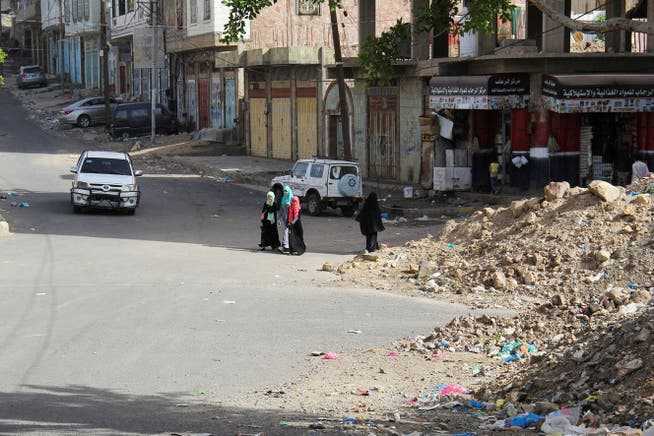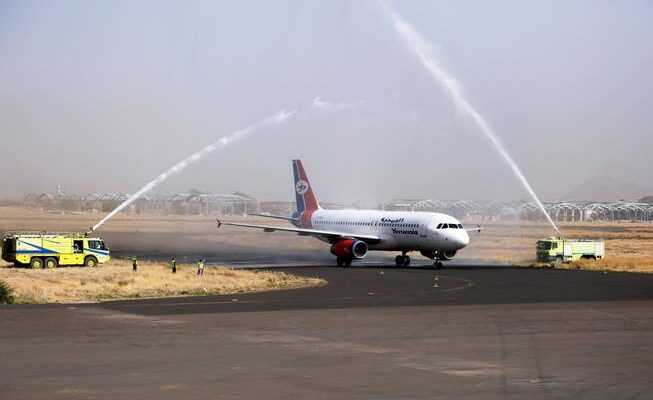There has been a ceasefire in Yemen for almost a month and a half. In the Houthi-controlled capital of Sana’a, airliners are even landing again. But the road to lasting peace in the devastated country is still long.
Welcome to Sanaa. A scheduled flight lands in the Yemeni capital for the first time in six years.
For years Sana’a was cut off from the world. However, on Monday at 8:15 am, an Airbus operated by Yemenia airline landed again at the airport in the Yemeni capital. The machine was greeted by two fire engines with a water fountain. A little later she took off again with 137 passengers, bound for the Jordanian capital Amman.
On board were mainly sick and injured. In recent years, they would have had to make their way over adventurous overland roads and past dangerous checkpoints to the airport in the port city of Aden, around 400 kilometers away, in order to get abroad from war-torn northern Yemen.
But now the capital Sanaa, which has been held by the Houthi militia since 2014, finally has a direct connection to the outside world again – six years after a scheduled flight last took off from here. After that, the airport was primarily the target of Saudi fighter jets.
For the first time in years, the guns fell silent
The flight was able to take off thanks to the ceasefire brokered by the UN at the beginning of April. Since then, guns have actually gone silent in Yemen for the first time after years of a devastating war between the pro-Iranian Houthi militia and the Saudi-UAE-backed government.
This is a relief for the population of the country hit by a hunger and supply crisis. Because as a result of the ceasefire, some of the sanctions with which the anti-Houthi coalition wanted to bring the militia to their knees were eased. For example, tankers with petrol can regularly dock in the port of Hodaya again. And the flight connections to Sanaa are to be expanded in the future.
The Yemen expert Maysa al-Din from the think tank Sanaa Center says that the situation in the areas controlled by the Houthi in the north of the country is already improving to a certain extent: “The acute fuel shortage has eased somewhat. Apart from that, the economic situation is still extremely difficult.”
Both sides are exhausted
It is unclear whether the calm will last or even lead to a peace process. The warring parties are still deadly enemies, and the armistice only came about because both sides are completely exhausted after years of bloody fighting.
The Saudis in particular are fed up with the never-ending war in their neighboring country and want to get out of the Yemeni swamp. Not least because of this, in April, Riyadh dropped its longtime protégé – President Abed Rabbo Mansur Hadi, who is hated by many Yemenis – and replaced him with an interim council.
The Houthi, however, did not like this move. A spokesman for the militia dismissed the government reshuffle as a “reshuffle of a few mercenaries”. The Houthis also declined an invitation to peace talks in Riyadh. They would not negotiate in the enemy’s capital.

In ruins: the city of Taiz is still under siege by the Houthis despite the ceasefire.
Nevertheless, the expert al-Din believes that the Houthi would also have an interest in negotiations: “The militia absolutely needs more food and fuel to supply their population,” she says. “In addition, their last major offensive in the oil province of Marib failed. It is therefore conceivable that the Houthis could agree to talks in an uninvolved third country.”
“Taiz shows how the Houthis operate”
The fighters, who are ostracized by the West, want to be recognized as the legitimate rulers of parts of Yemen. They prove to be tough negotiators whose promises cannot always be taken at face value.
As in the city of Taiz. The important economic center south of Sanaa is held by government troops, but is almost completely cut off from the outside world by Houthi fighters. Despite promises to the contrary, the mountain warriors have not lifted the siege and continue to block access roads into the city, possibly to force further concessions.
“Taiz shows how the Houthis operate,” says al-Din. “They make maximum demands and don’t stick to any agreements.” This does not make the movement a trustworthy interlocutor and tarnishes the prospects for a lasting peace. “In recent years, the Houthi have learned that they can achieve a lot with armed force,” says al-Din. “Why should you change your approach now?”
